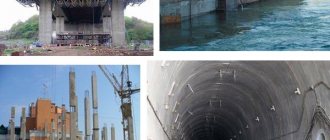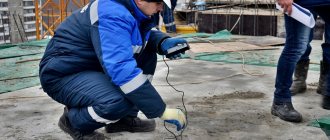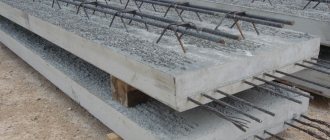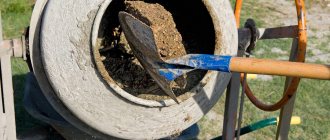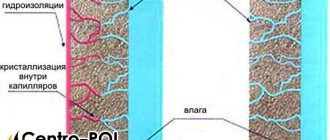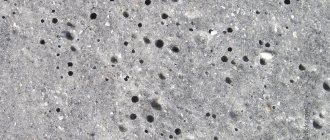Before release or before use during construction work, the quality of concrete is checked. This material must comply with regulatory requirements. Let's talk in more detail about why such tests are needed, why they are important and how they are carried out.
The strength and some other qualities of concrete building materials determine how safe the buildings in the construction of which they were used will be. If a concrete structure cannot withstand heavy loads or is unstable to temperature changes, it may collapse. Destruction will entail a violation of the integrity of the entire structure where such concrete was used, and will lead to harm to the health or life of people.
That is why current regulations require testing of concrete before its use.
The central place among these documents is occupied by GOST 10180-2012.
Types of tests
There are several types of concrete examination:
- Visual inspection. The concrete mixture or finished reinforced concrete structure is inspected without the use of special instruments and methods for deviations from the requirements of the standards.
- Laboratory tests. The building material is examined by the laboratory using special equipment.
- Cone check. Used to determine the plasticity and fluidity of concrete mortar.
The testing of concrete is completed by drawing up a special report, which reflects their results and the characteristics of the building material in numerical terms.
Areas of activity of the laboratory
Cement quality control
The laboratory checks all batches of cement entering the plant territory for their compliance with the requirements of GOST 310.3. In the course of this work, they determine it:
- Activity
- Grinding fineness
- Setting time
- Density indicators
- Mark
- Uniformity of changes in the volume of concrete mixture
Sand quality control
The MOSBETONTORG Research Center strictly ensures that the sand used in production is enriched and well washed. Before accepting a batch of this building material, the head of the laboratory personally arrives at the quarry and takes control samples of sand there. Later, with the help of a laboratory engineer, he determines the following properties of the samples taken:
- Humidity level
- Grain composition
- Size module
- Filtration coefficient
Also, during these studies, the presence or absence of impurities, contaminants, clay and other components in the sand is determined. Having received this information, laboratory workers record it in the incoming control log. After which they compare the performance of all batches of sand entering the plant with it and document deviations.
Crushed stone quality control
Inspection of this building material begins from the moment it is unloaded at the plant. A research center employee takes a sample and then determines its compressive strength and frost resistance. He also studies the composition of the crushed stone taken for analysis and determines its brand.
Concrete mix quality control
The concrete mixture is evaluated according to the following indicators - the strength of the material, its waterproofness and frost resistance. The data obtained is entered into the finished materials research journal. Later, based on them, the laboratory team determines whether the concrete meets the required quality or not.
All products that have passed the test are provided with:
- Quality certificate
- Certificates of conformity
- Hygienic conclusions
- State regulatory standards
Goals and objectives of professional concrete testing
The main purpose of testing concrete using the non-destructive GOST method in the laboratory is the timely detection of non-compliance with design documentation at the initial stage of construction. But from concrete cubes taken for destructive testing, it is not always possible to accurately determine the main operational parameters of the material used at construction sites. There are two options for this situation:
- Departure of specialists to the site to conduct laboratory tests of concrete and draw up a concrete testing report in field conditions.
- Cutting samples (core) from the wall or foundation of an object using diamond drilling and testing the concrete in a specialized laboratory.
The reliability, safety and durability of buildings erected with their help directly depend on the quality and strength characteristics of concrete mixtures. Guided by Russian regulatory documents GOST, SP and SNiP, specialists from the FCC No. 1 testing laboratory successfully solve important research tasks, including testing concrete for:
- frost resistance;
- mobility;
- strength;
- workability;
- waterproof and water absorption;
- concrete continuity testing.
To confirm the declared indicators and characteristics of the material, experts use special-purpose equipment and proven concrete testing schemes. The ultrasonic method of examination, the methods of elastic rebound and separation with chipping are used.
It is important to know.
You can receive a concrete strength test report within one day. Strength indicators must be taken into account in the design process and load calculations. When carrying out laboratory work and drawing up a protocol for testing concrete for strength, we focus on the requirements of GOST.
Timely testing of concrete and mortars for strength will help prevent the use of low-quality mortars and avoid the threat of destruction of the building structure.
What laboratory methods for testing concrete can determine
- Compressive strength from samples taken from a building structure - a method in which cores are taken from the sample under study. After special preparation, finished samples (cubes) are sent for testing under a press;
- Compressive strength based on control samples. When pouring a monolith on site, special forms are filled with the same concrete mixture, after which the resulting concrete cubes are tested on a press using a special device on the 7th and 28th days;
- Density is an indirect indicator of the composition of the mixture and compound. May indicate quantity and quality of aggregate;
- Frost resistance is an indicator that allows you to determine the grade of concrete. During testing, manufactured building samples undergo multiple freezing and thawing cycles. Based on the experimental data obtained, a conclusion is drawn about the ability of concrete to maintain its strength characteristics unchanged;
- Water resistance is the property of concrete in a frozen state not to allow water to pass through its thickness. Determined by the wet spot method. This analysis is relevant for determining the limit of walls buried in the ground, foundations of building structures and plinths;
- Water absorption is the ability and speed of moisture absorption in a drop-liquid state. The results of the study directly depend on the porosity of the concrete;
- Tensile strength in bending is determined in structures where it experiences appropriate loads. The study consists of determining the breaking load of concrete under mechanical deformation and pressure;
- Abrasion is an important indicator in cases where concrete is used as flooring and other coverings that are subject to constant wear and tear (roads, parking lots, warehouse floors, asphalt paths and other reinforced concrete surfaces). The stiffening ribs are of particular importance.
When an examination of the strength and quality of concrete is required
An independent examination of concrete may be needed at the very beginning of construction, at the first suspicion of the use of low-quality concrete mixtures and at the final stage of construction. The basis for conducting expert tests of concrete for strength can be a court ruling, a statement from the developer or organization itself. We are ready to deal with the most difficult situations. An individual approach to each client, transparent pricing for concrete testing will help you make the right choice.
The base of our laboratory allows us to carry out all types of concrete examinations at a decent professional level, including testing the compressive strength of heavy concrete using a press.
Testing
Both producers and consumers of concrete are interested in determining its strength. To do this, laboratories test concrete cubes or drilled cylinders. Samples are taken from a batch of mixture at intermediate and design ages (28 days). Cubes have edge sizes of 100, 150, 200 or 300 mm. The cylinders have a diameter of 100, 150, 200, 300 mm, and a height equal to two diameters.
Making samples
To produce samples, special metal molds with cells having an internal edge measuring 100 mm are used. When making samples, standardized dimensions are provided. The 2FK-100 type shape is convenient because it provides a standardized tolerance in the perpendicularity of adjacent faces. It is also rational in the production of samples due to manufacturability and speed of assembly and disassembly and low weight.
During production:
- Take a sample of the mixture from the middle of the batch (when using a concrete pump - in 3 doses over 10 minutes with mixing before placement).
- The mixture is laid and compacted no later than 20 minutes after sampling and no higher than 100 mm of layer height. When the cone draft is more than 10 cm, laying is done by bayoneting. With less OK, vibration is additionally applied.
- Prepare a series of samples for testing (3-4 pieces in a series) under the same conditions. Permissible deviations in the average density at the time of testing concrete cubes do not exceed 50 kg/m3.
- Defective samples are selected. Before testing concrete cubes for strength, those containing foreign inclusions, cavities, chipped ribs, cracks, areas of weak compaction and delamination (except for large-porous concrete) are removed from the series.
- Testing of concrete samples for compression or strength is carried out in a number of batches of material at a design age equal to 28 days, regulated by clause 5.2. GOST 18105.
- Incoming control requires special storage conditions for samples (air humidity 95%, temperature - +20 degrees). Permissible deviations in humidity are 5 percent, temperature is 3 degrees.
Tests are carried out using different methods that are optimal for determining a specific parameter. Non-destructive research methods include the use of ultrasonic sounding, elastic rebound, shock pulse, and separation with chipping. Sometimes combined testing methods are used.
Based on the results of the tests, an official expert opinion is drawn up. The document contains:
- results of the research;
- assessment of concrete mixture parameters;
- recommendations for the operation of the structure or the use of concrete.
The document confirms the suitability or unsuitability of concrete and the possibility of further operation of the structure. The recommendations are aimed at improving the quality of the concrete mixture, changing its composition, eliminating structural defects or stopping the operation of the facility.
Our work standards
- Quality and efficiency.
A quick response to customer requests, strict adherence to deadlines for testing concrete for strength using non-destructive methods are the advantages of our laboratory. - Wide coverage and full range of services.
We conduct tests of concrete “cubes” and cores, inspections of buildings and structures, and all types of construction expertise. Engineers can travel to any city in the Russian Federation. - Reasonable justified prices for concrete examination.
- Providing discounts
and special offers for large volume orders.
Testing of reinforced concrete, concrete, concrete mixtures
Concrete is one of the main discoveries in the construction industry.
Thanks to this material, concrete construction has become the most efficient and less labor-intensive. In the 21st century, concrete is the most common material on a construction site and the basis for products in civil and industrial construction, complies with GOST. Due to its various physical and mechanical properties, its low cost and ease of use, the material is used both in small-scale construction of building structures on site, and is used in the construction of the most large-scale and critical buildings and structures (for example: energy, military affairs, etc.). Concrete is a multicomponent material, usually consisting of coarse aggregate, fine aggregate, binder and various additives. Despite all the positive physical and mechanical characteristics of reinforced concrete, this building material is quite “capricious” during its production, during pouring, maintenance, operation, etc., therefore it is necessary to comply with the following requirements and use a special method. In order for the construction concrete mixture to be of good quality, you first need to correctly select the composition and volume of the concrete mixture according to the required ratio of its components (crushed stone). After this, within a certain period of time, without delay or interruption, deliver the prepared mixture to the construction site or structure (during movement, do not overexpose, do not shake, etc.). Next, you need to follow the technology of pouring concrete mixture coatings, mortar into the structure, and properly care for the structure on the site (avoid humidity, do not overheat, do not freeze, do not overdry, etc.).
Conclusion
If a construction company that owns its own mobile concrete is of high quality for its products, then this can be done in two ways:
- Buy and maintain your own laboratory that monitors the quality of produced building mixtures.
- Conclude an agreement with a specialized company that provides professional laboratory outsourcing services.
You can learn more about the specifics of the operation of concrete production equipment in the “Concrete Plants” category.
How concrete and concrete mixtures are tested
Checks begin to be carried out even before the formation of the concrete mixture begins. In order to obtain a high-quality product or structural element (in relation to monolithic reinforced concrete slabs), it is necessary to ensure compliance with the following conditions for the concrete mixture laying technology:
- average composition density;
- temperature conditions;
- elimination of delamination and porosity;
- oxygen access, etc.
The strength of concrete specified by technical conditions is formed under the influence of factors of physical and chemical properties at each stage of the manufacture and use of a building or structure:
- preparing individual components for pouring;
- mixing concrete mixture at a specialized complex;
- pouring the prepared concrete mixture under the formwork or into a mold (for standard products);
- gaining strength over a set period of time;
- during the operation of the constructed facility.
The period for intermediate testing of concrete strength is 7 days after pouring the concrete mixture. During this period, the strength reaches about 70% of that specified for the corresponding class (grade) of concrete at the design age. After 28 days from the date of production of concrete, 100% strength is achieved. But in fact, the increase in strength continues for several decades, followed by rapid destruction after the expiration of the standard service life.
Types of equipment for a concrete plant laboratory
The minimum configuration of a concrete laboratory includes 10 basic elements:
- Vibrating platform for determining the characteristics of a building mixture.
- Devices with which concrete is tested for delamination, solution and water separation.
- Special scales are a precise instrument for determining the strength, density of concrete, moisture level, and its constituent ingredients.
- A sieve that disperses crushed stone and sand.
- A dryer is a cabinet in which the degree of moisture content of inert substances is determined.
- A set of special measuring instruments - rulers, hydrometers, measuring cylinders, etc.
- A device that determines the degree, at what speed and how strongly concrete thickens and sets.
- A device that determines the level of hardness.
- A cone-shaped device that determines the degree of mobility of the building mixture.
- An air meter that measures the amount of air contained in concrete.

